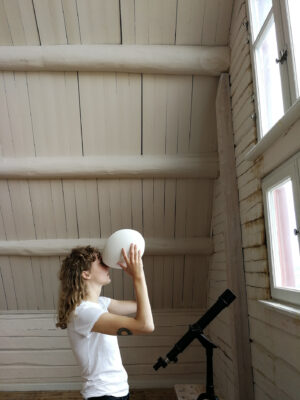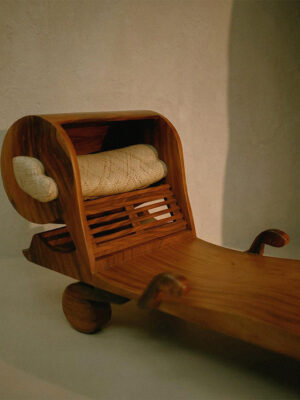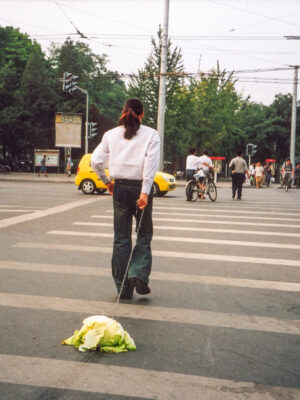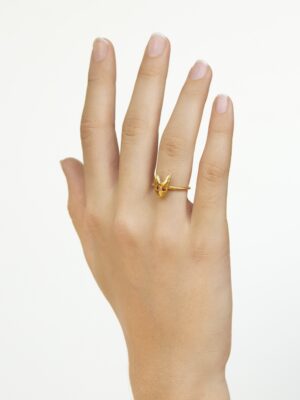These eggs were designed to astonish, to carry secrets within secrets, worlds within worlds. But the egg itself holds wonders of its own. I think of this as I pick one up at my neighbour’s farm, still warm from the nest. So dignified in a royal setting, yet it carries stories of the warmth of a simple bed of straw. I recall how the children’s story Solägget (The Sun Egg) by Elsa Beskow captures the wonder an egg can evoke – an everyday marvel, full of mystery: ‘Imagine that the sun has laid an egg here in the forest!’ In Beskow’s world, nature and imagination intertwine, and just as she used her stories to question societal hierarchies, the egg, too, shifts between different meanings – from a treasure for the elite to a symbol of shared, fundamental life.
Across cultures, the egg has signified hidden potential and transformation. In many global mythologies, the cosmos is born from a cracking eggshell. The egg also holds significance in feminist thought – both a symbol of constraint and, at the same time, a site of autonomy, creation, and the divine. This enduring fascination with the egg finds new expression in contemporary art. In the following, I explore how three Swedish artists – Hedvig Bergman, Valeria Montti Colque, and Helena Sandström – engage with the egg, asking them about its role in their work.
___STEADY_PAYWALL___
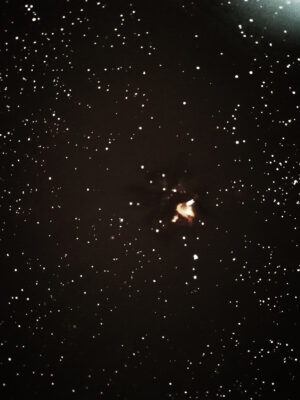
At one point in artist Hedvig Bergman’s sculptural explorations of eggs, she peered into a tiny hole in a hollow eggshell. As light streamed in through its pores, she was met with a vision of a starry sky. It was as if the egg contained the cosmos itself. ‘The shift in perspective completely absorbed me,’ she recalls, ‘and I couldn’t really talk about anything else other than eggs in relation to my work.’
In the beginning, Hedvig Bergman was mostly led by an intuitive attraction to the form – the way an egg feels in the hand, its simple beauty. But the egg keeps offering countless new dimensions through its presence in human culture and mythology. Bergman notes how the everyday handling of eggs, close to the body and the home, can speak intimately of personal childhood memories, while at the same time containing broader perspectives of violence and care, life and death.
Bergman investigates a spectrum of qualities of the egg in her work – from its sculptural dryness to the chemistry of its wet contents. Through the concept of the ‘cut’ – a rupture that both transforms and reveals – Bergman exposes the egg’s corporeal boundary state, and what lies beneath its fragile shell, often broken or pierced in her work.
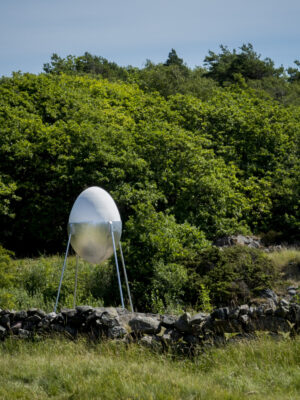
When Hedvig Bergman travelled to Russia to learn more about the history of the Fabergé eggs, she stumbled upon the Museum of Cosmonautics in Moscow. The Sputnik became yet another point of connection to the architecture of the egg, and its capacity to hold both micro and macro perspectives. For Bergman, it also sparked thoughts about humanity’s impulse to mimic and domesticate nature.
Inspired by Sputnik, she decided to experiment with scale for an exhibition at an open-air sculpture park in western Sweden. ‘At the time, I was thinking a lot about motherhood and became newly aware of the egg’s significance. It made me want to explore the egg on the scale of my own body,’ she told me. In the sculpture park, Bergman placed the egg in a stand identical to that of the Sputnik spacecraft, which in turn resembles the way Fabergé eggs are held in their ornate supports. Resting in its cup, the egg conveys a quiet anticipation – a vessel of stillness, or a vehicle: a movement through time. On the very day Hedvig Bergman learned she was pregnant with her first child, she received word from the sculpture park that the shell of her egg sculpture had been broken.
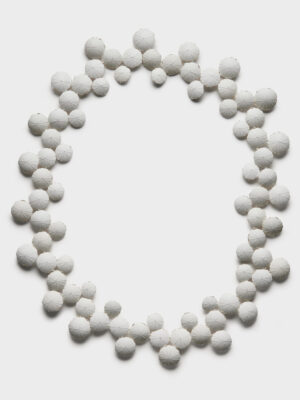

With meticulous precision and patience, jewellery artist Helena Sandström stitches together fragments of eggshells using pearl silk thread. She draws inspiration from the tactile experience of handling eggshells – something familiar to almost everyone. The delicate shells form small capsules, at once archaic and otherworldly. Sandström’s egg jewellery engages with the tradition of classic pearl necklaces, where each pearl is separated by a knot. If an eggshell breaks in the necklace, it leaves a hole, an emptiness. It’s important to her that her work connects to the body, as it is made to be worn. For her, the pearls reflect the personal relationships we hold close – and the experience of loss.
‘Though eggshells appear fragile, their arched structure actually provides surprising resilience,’ Sandström explains, ‘as an architecture designed to withstand pressure while protecting what lies within.’ The duality and multifaceted associations evoked by eggshells lend an enigmatic air to Sandström’s jewellery. People often mistake them for seashells, as eggshells might be regarded as ordinary and ephemeral within the realm of jewellery. The choice of material and the slow, deliberate process is an act of resistance. Sandström’s works question the pace of society and overconsumption, the value of our time, and serve as a reminder that the present state of life can’t be taken for granted.
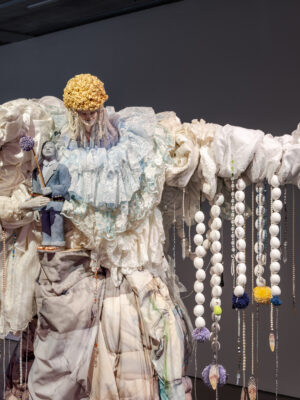
Stepping into Valeria Montti Colque’s exhibition Cosmonación – Modersberget (‘Mother Mountain’) at Bonniers Konsthall in the spring of 2025 is to enter a welcoming cosmos where identities merge and dissolve. Through sculptures, installations, video and performance, she weaves together her Swedish and Chilean heritage, with diasporic voices speaking from an Andean horizon. Montti Colque’s characters embody a sense of shared existence, where the individual is inseparable from collective geographies and memories. The mother figure, a recurring presence, appears as a mountain – solid yet fluid in her contours – embracing all her relations, lands, and dreams. Through textiles, birds, paintings, frying pans and countless feet dressed in glitter-adorned sneakers, Montti Colque’s sculptures are layered with histories both personal and mythological.
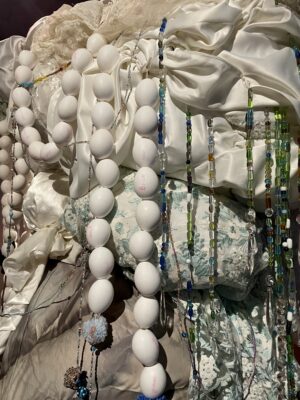
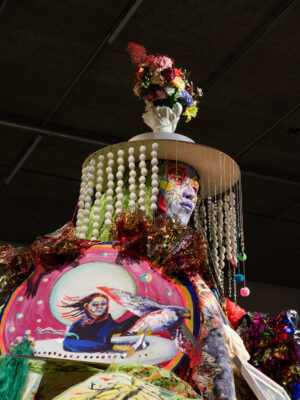
And the egg, you may ask? Where to begin – eggs are everywhere. Strung as necklaces, cascading in veils around figures’ heads. Worn as adornments, while also evoking sustenance and function, like armour. Mother Mountain wears her eggs like a curtain of pearls around her hat. Montti Colque has said that, for her, the eggs represent childhood. I think of how childhood, just like eggs, can be joyful, shared, and full of promise, while at the same time being fragile and exposed. The eggshells in her sculptures all bear the colourful industrial stamps familiar from supermarket cartons. When I notice the stamps, I pause – at Montti Colque’s ability to embrace the vastness of life’s mysteries, its sorrows and celebrations. Because as a friend, daughter, and mother – as much as she remains the steady mountain that holds the universe – she must still make sure everyone is fed and content, right?
The egg carries the weight of history while remaining embedded in the present – cracked open in kitchens, resting in careful hands, holding unseen futures. It speaks of cycles that stretch beyond the individual. In the works of Bergman, Sandström, and Montti Colque, the egg is never static; it is broken and repaired, held and transformed. It materialises at the threshold between the ordinary and the extraordinary, the breaking and remaking of worlds.
This year’s theme for our digital publishing is Language. Through a selection of articles we dive into visual languages, the communication of objects, iconography and symbolism. Focusing on story-telling through a lens of aesthetics, we are eager to bring assorted trains of thought to you by twelve different authors. The articles range from speculative to theoretical, chaste to raunchy, past to future, bringing you a variety of voices and perspectives.
This year’s digital publishing features isabel wang pontoppidan as guest editor. isabel is a Danish-Chinese writer, artistic researcher and jewellery maker based in Amsterdam. Her practice is multi-pronged, combining writing, performance, research and jewellery in a variety of overlapping cross-sections.
Cover image:
Hedvig Bergman • the Egg • 2018 • Photo: Hedvig Bergman
Commissioned by Current Obsession.
